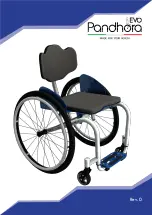
~ 9 ~
Overall user manual
© 2010 VAN OS MEDICAL UK LTD.
Tel. +44(0)1757 701177, Fax +44(0)1757 706011, E-mail:
,
www.vanosmedical.com
-
The attendant is already standing on the pavement and makes sure that the wheelchair stands with the rear
wheels as closely to the pavement as possible. The user of the wheelchair needs to lean backwards. This way
the wheelchair will tip backwards and the attendant can pull the chair on the pavement. The attendant needs
to make sure that the front wheels are on the pavement before he lets the wheelchair down.
If you want to go up a pavement alone, you should move your weight as far forward as possible by bending forward.
Then you must provide a so-called 'Wheelie', to get the front wheels on to the pavement (see figure 3, under the
heading “Warnings for safe use”). You can only perform this action if you have practiced it with a trained expert.
Going down the pavement:
If you want to go down the pavement, we advise you to do this with an attendant. The attendant should move the
wheelchair forward to the curb. Then the user should lean back so the attendant can tilt the wheelchair to find a
balance point. When the wheelchair is balanced the attendant can move the wheelchair slowly off the curb. When
the wheelchair is off the pavement, the attendant can let the front wheels back onto the ground.
If you want to independently go off the pavement, you should do this in reverse (Figure 11 shows what not to do).
You can do this only if you've practiced with a trained expert.
4.3 Going up and down ramps
Most people can climb short slopes by themselves. This of course depends on your body strength, stamina and the
gradation of the slope. Inspect the slope always for risks, such as holes or slippery and uneven surfaces before you
drive off. If you can not see the slope, ask someone to inspect it for you.
Warning:
A slope of more than 5 degrees can be dangerous to descending or climbing. Remember that the
friction of your hands to grab the hand rim is the only way to brake while driving.
Most people develop their own methods to drive up slopes through practice. Sit with your upper body slightly
forward as you climb the slope. Should it be necessary to stop on the slope, you must try to avoid unexpected
movements which may cause tilting when climb further (Figure 12).
If you want to climb a relatively steep slope, we advise you to use the assistance of a supervisor, figure 13.
11
12
13










































